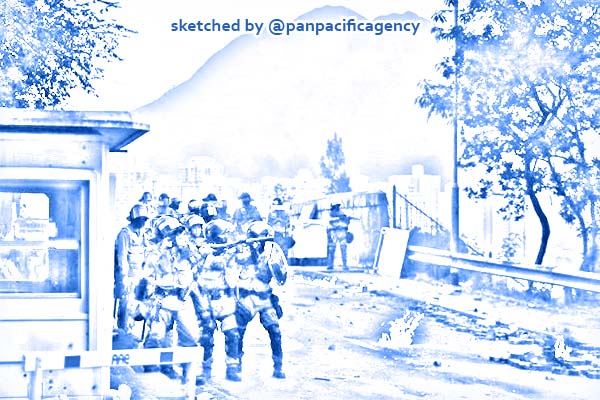Hong Kong police start firing tear gas on universities

Riot police aim tear gas gun to university students during a crash at Chinese University in Hong Kong, Monday, Nov. 11, 2019. AP-Yonhap. Sketched by the Pan Pacific Agency.
HONG KONG, Nov 12, 2019, SCMP. Hong Kong police fired tear gas in tertiary institutions for the first time on Monday, with Chinese University turned into a smoking battlefield where student protesters and officers were locked in a tense stand-off for seven hours, The Korea Times reported.
The widespread traffic disruption in the morning, caused by anti-government protesters calling for a citywide strike, also prompted 11 universities to cancel classes. All but one of them would continue to suspend classes on Tuesday.
On Monday morning, police entered Chinese University (CUHK), Polytechnic University and the University of Hong Kong (HKU) to take action against protesters, firing tear gas on the first two campuses.
The confrontation at CUHK in Sha Tin started at 8am, after objects were seen thrown onto MTR tracks at a nearby station. Police then entered the campus through a bridge from an entrance near Tolo Harbour and set up a defensive perimeter there.
Another group of officers, who were clearing barricades on Tai Po Road, fired the first volley of tear gas into the campus at 11am. Dozens of students guarded the entrance along that road, shielding themselves with umbrellas.
Throughout the day, more than 100 tear gas rounds, sponge grenades and rubber bullets were fired by police, while protesters hurled bricks and petrol bombs. At least three people were arrested at CUHK.
A young male student protester from the university said he was angry with police’s use of firearms. “They already shot a few rounds at Sai Wan Ho earlier today. When I saw that, I cried,” he said, adding that the shooting of a 21-year-old demonstrator had brought more people to the streets.
A CUHK staff member in his mid-20s, who did not want to be named, said it was absurd that police had entered the campus without a warrant. “Once police are out, there will be conflict,” he said, adding that protesters were only trying to keep officers off the campus.
Towards the end of the stand-off, Democratic Party lawmaker Roy Kwong Chun-yu, also a popular romance writer, arrived at the scene, to the cheers of some students.
Police justified their actions at an afternoon press conference. “Are they CUHK students? I hope not … They threw petrol bombs and objects at officers. No university campuses should be havens for criminals,” said Chief Superintendent Kelvin Kong Wing-cheung.
Last month, police sparked controversy by entering the Sha Tin campus, allegedly without the school’s consent, in the early hours of a Sunday, tracking down and arresting five students who were putting up protest-related posters.
At the time, CUHK expressed concern and urged police to contact university management before entering, whenever practicable.
Demonstrators carry a goal post during an anti-government protest at the Chinese University of Hong Kong in Sha Tin, Hong Kong, China November 12, 2019. Reuters-Yonhap
It remained unclear whether police had on Monday entered the campus without telling management. The Post has approached CUHK for comment.
Chaos also erupted at PolyU in Hung Hom, where protesters set plants and rubbish on fire on their campus. Glass panels on the Li Ka Shing Tower were broken, and multiple entrances to the institution were blocked with metal barriers and plants.
On a footbridge near campus, protesters threw chairs onto roads below that led to the Cross-Harbour Tunnel. One person threw a petrol bomb from the bridge onto the road outside PolyU, causing a fire. Police responded with tear gas and an officer raised a crowd-control gun at protesters.
PolyU, in a statement, expressed “deep regret” for the conflicts that happened on its campus. The school noted that riot police gave chase to protesters suspected of blocking roads. It “strongly condemned” the violence and said it “reserves the right to take appropriate actions”.
At HKU in Pok Fu Lam, the MTR station entrance was set on fire at 9.30am. Police fired at least one round of tear gas. Students set up barricades at the gates of the school.
Police said officers entered HKU to try to arrest rioters who had retreated there, and during their operation inside the campus, protesters gathered and threw bricks and petrol bombs.
A demonstrator points to the smashed windscreen of a damaged car during an anti-government protest at the Chinese University of Hong Kong in Sha Tin, Hong Kong, China November 12, 2019. Graffiti on the car reads, “Murdering students.” Reuters-Yonhap
HKU later confirmed in a statement that five of its students were arrested, and that its vice chancellor had written to the police commissioner to ask that the force ensure the rights of those detained.
The university also said it was informed by police that they were responding to 999 calls, one of the exceptions in which officers were allowed on campus.
“We understand that these are times when emotions are running high everywhere. We are also very saddened to see the casualties and loss of life arising from the protests,” HKU chief Zhang Xiang said.
The pro-establishment Federation of Education Workers condemned the disruptions by protesters, saying the actions had impeded their educations.
The pro-democracy Professional Teachers’ Union on Monday called for the government to require all kindergartens and secondary schools to suspend classes on Tuesday, but the Education Bureau did not announce any change of plans.
Teddy Tang Chun-keung, chairman of the Hong Kong Association of the Heads of Secondary Schools, said that, as far as he knew, most secondary schools would maintain normal operations on Tuesday.
Even so, some schools had already notified students and parents that they could decide if classes should be attended, depending on the traffic situation, adding that those who showed up late would be allowed flexibility.